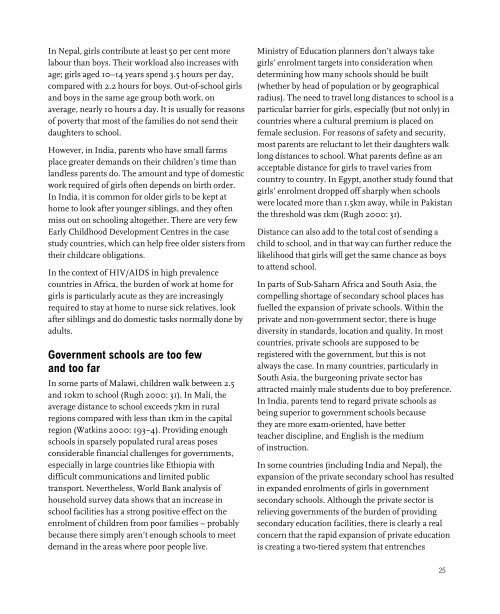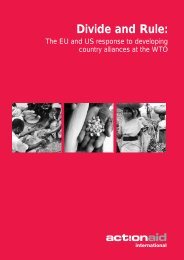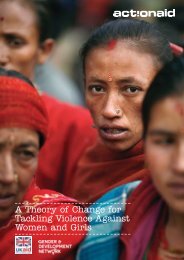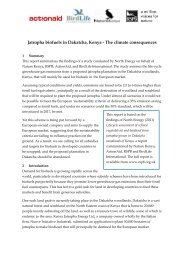A fair chance - United Nations Girls' Education Initiative
A fair chance - United Nations Girls' Education Initiative
A fair chance - United Nations Girls' Education Initiative
Create successful ePaper yourself
Turn your PDF publications into a flip-book with our unique Google optimized e-Paper software.
In Nepal, girls contribute at least 50 per cent morelabour than boys. Their workload also increases withage; girls aged 10–14 years spend 3.5 hours per day,compared with 2.2 hours for boys. Out-of-school girlsand boys in the same age group both work, onaverage, nearly 10 hours a day. It is usually for reasonsof poverty that most of the families do not send theirdaughters to school.However, in India, parents who have small farmsplace greater demands on their children’s time thanlandless parents do. The amount and type of domesticwork required of girls often depends on birth order.In India, it is common for older girls to be kept athome to look after younger siblings, and they oftenmiss out on schooling altogether. There are very fewEarly Childhood Development Centres in the casestudy countries, which can help free older sisters fromtheir childcare obligations.In the context of HIV/AIDS in high prevalencecountries in Africa, the burden of work at home forgirls is particularly acute as they are increasinglyrequired to stay at home to nurse sick relatives, lookafter siblings and do domestic tasks normally done byadults.Government schools are too fewand too farIn some parts of Malawi, children walk between 2.5and 10km to school (Rugh 2000: 31). In Mali, theaverage distance to school exceeds 7km in ruralregions compared with less than 1km in the capitalregion (Watkins 2000: 193–4). Providing enoughschools in sparsely populated rural areas posesconsiderable financial challenges for governments,especially in large countries like Ethiopia withdifficult communications and limited publictransport. Nevertheless, World Bank analysis ofhousehold survey data shows that an increase inschool facilities has a strong positive effect on theenrolment of children from poor families – probablybecause there simply aren’t enough schools to meetdemand in the areas where poor people live.Ministry of <strong>Education</strong> planners don’t always takegirls’ enrolment targets into consideration whendetermining how many schools should be built(whether by head of population or by geographicalradius). The need to travel long distances to school is aparticular barrier for girls, especially (but not only) incountries where a cultural premium is placed onfemale seclusion. For reasons of safety and security,most parents are reluctant to let their daughters walklong distances to school. What parents define as anacceptable distance for girls to travel varies fromcountry to country. In Egypt, another study found thatgirls’ enrolment dropped off sharply when schoolswere located more than 1.5km away, while in Pakistanthe threshold was 1km (Rugh 2000: 31).Distance can also add to the total cost of sending achild to school, and in that way can further reduce thelikelihood that girls will get the same <strong>chance</strong> as boysto attend school.In parts of Sub-Saharn Africa and South Asia, thecompelling shortage of secondary school places hasfuelled the expansion of private schools. Within theprivate and non-government sector, there is hugediversity in standards, location and quality. In mostcountries, private schools are supposed to beregistered with the government, but this is notalways the case. In many countries, particularly inSouth Asia, the burgeoning private sector hasattracted mainly male students due to boy preference.In India, parents tend to regard private schools asbeing superior to government schools becausethey are more exam-oriented, have betterteacher discipline, and English is the mediumof instruction.In some countries (including India and Nepal), theexpansion of the private secondary school has resultedin expanded enrolments of girls in governmentsecondary schools. Although the private sector isrelieving governments of the burden of providingsecondary education facilities, there is clearly a realconcern that the rapid expansion of private educationis creating a two-tiered system that entrenches25
















